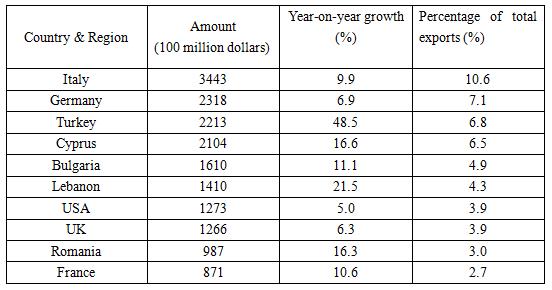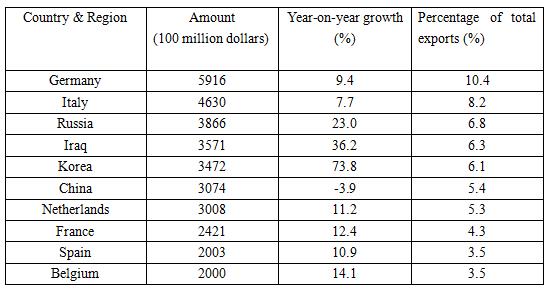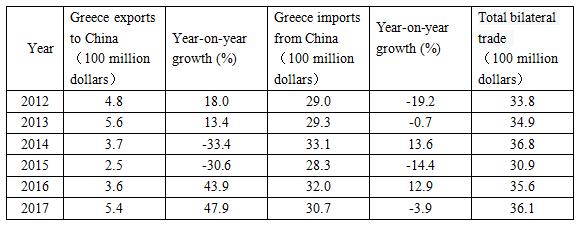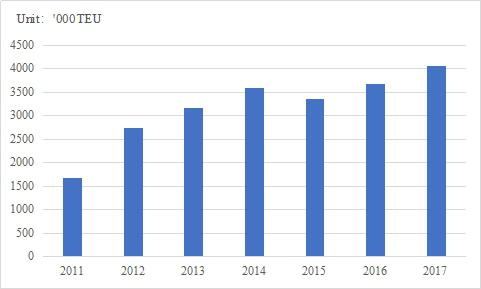The Greek economy accounts for only 2% of the European Union. It is an insignificant economy in the European Union. Yet such a small economy triggered a wild EU debt crisis and made Ireland, Portugal and even Spain, Italy and other countries successively fall into crisis, which is a vivid example of globalization and financial contagion. Statistics shows that Greece's debt burden is still heavy. Its GDP in 2018 is estimated to be about 185 billion Euros, and its debt share in GDP is about 180%, which is not much different from that in 2017. In the next few years, Greece is expected to adopt austerity policies such as tax increases and pension reductions.

Fig.1. GDP of Greece (Unit: billion U.S. dollars)
Source: World Bank
Statistics from Eurostat shows that the total import and export volume of Greece in 2017 was 89.34 billion US dollars, an increase of 16.0% over 2016. Among them, exports was 32.61 billion US dollars, an increase of 15.8%, and imports $56.73 billion, an increase of 16%. The trade deficit was 24.12 US dollars, an increase of 16.3%.
Table 1 Exports to major trading partners of Greece in 2017

Source: China's Ministry of Commerce
Table 2 Imports from major trading partners of Greece in 2017

Source: China's Ministry of Commerce
From national angle, in 2017, top 4 countries that Greece exported most are Italy, Germany, Turkey and Cyprus. These 4 countries accounted respectively for 10.6%, 7.1%, 6.8% and 6.5% of total Greek export. Top 4 countries that Greece imported most are Germany, Italy, Russia and Iraq. These 4 countries accounted respectively for 10.4%, 8.2%, 6.8% and 6.3% of total Greek import.

Fig.2. The amount and proportion of major export products of Greece in 2017
Source: China's Ministry of Commerce

Fig.3. The amount and proportion of major import products of Greece in 2017
Source: China's Ministry of Commerce
Greek trade deficit is mainly from Russia, Germany and Iraq. Trade deficit in 2017 with the 3 countries is 36 billion dollar, 36 billion dollar, 35 billion dollar, respectively, increasing 23.9%. Cyprus and Lebanon are top 2 sources of Greek trade surplus. Trade surplus with the 2 countries is 1.66 billion dollar and 1.37 billion dollar, respectively, increasing 20.1% and 21.2%.
From angle of goods, mineral products, base metals and products, food and drink, tobacco and mechanical and electrical products are top 4 goods Greece exported. Mineral products, chemical products, mechanical and electrical products, transportion equipments are top 4 goods Greece imported.
Statistics from Eurostat indicates that bilateral trade volume between China and Greece is 3.61 billion dollar in 2017, increasing 1.4%. Greece exported 0.54 billion dollar to China, increasing 47.9% and accounting for 1.7% of total Greek export, growing 0.4% more than last year. Greece imported 3.07 billion dollar from China, decreasing 3.9% and accounting for 7.0% of total Greek import, dropping 1.1% less than last year. Trade deficit of Greece to China is 2.54 billion dollar in 2017, dropping 10.5%. Mineral products are the largest goods which Greece exported to China and electromechanical products are the largest goods which Greece imported to China.
Table 3 Bilateral trade between Greece and China

Source: China's Ministry of Commerce
Piraeus port is located on the northeast side of Saronikos Bay, southeast coast of Greece, bordering the southwest side of the Aegean Sea. It is the largest port in Greece and one of the top 10 container terminals in Europe. The inland area of the port can reach to the Balkans. Maritime transport can cover the entire Mediterranean, Black Sea, North Africa and other surrounding areas. Location of the port is very critical.
It is the main port for the "21st century Maritime Silk Road" to enter Europe. It can be connected with the Silk Road Economic Belt through the Central European Continental Sea Express Line.

Fig.4. Container throughput of Piraeus Port(2011-2017)

Fig.5. Dry bulk throughput of Piraeus Port(2011-2017)
In 2005, Greece's economy was in recession, and workers in many enterprises began to strike on a large scale. The port of Piraeus was no exception. As a result, many shipping enterprises had to transfer the goods originally docked in this port to other ports, resulting in a rapid 10% reduction in cargo throughput.
In 2008, in the context of Greece's debt crisis, COSCO Maritime Group won the bid for privatization of container terminals 2 and 3 at Piraeus Port, and obtained its 35-year franchise, which took over the operation of the terminal in 2010.
This move aroused strong concern and controversy at that time. Many voices believed that the Chinese could not manage such ports well and that the employment of local Greek workers would be seriously affected. In fact, since COSCO took over the container business of Piraeus port, it has not dismissed workers without reason, but has created at least 1500 local jobs. COSCO has greatly increased its container business and operational efficiency by introducing advanced management technology and experience, thus creating the agglomeration effect of the industrial chain.
After arduous negotiations, COSCO and the Development Fund of the Greek Republic signed an agreement in April 2016. COSCO acquired a 67% stake in Piraeus port for 368.5 million Euros. In June of the same year, the Greek Parliament approved the deal. According to the agreement, COSCO will invest 300 million Euros in port infrastructure construction in the next five years in addition to transaction expenditure. Through this transaction, COSCO (Hong Kong) became the largest shareholder of the Piraeus port. Meanwhile, this is the first time that Chinese enterprises take over the whole port overseas.
Despite the adverse effects of the international financial crisis and the Greek debt crisis, the loading and unloading volume of the port of Piraeus has been increasing in recent years. The port's container throughput increased from 0.88 million in 2010 to 4.05 million in 2017, and its global ranking rose sharply from No.93. Brilliant report cards pave the way for further development of COSCO in Piraeus port.
On August 27, 2018, China signed an understanding memorandum with Greek government to build "the Belt and Road" together. Greece became the first developed European country to sign such a memorandum with China. The two sides will take the signing of the understanding memorandum as an opportunity. They will cooperate closely to link " the Belt and Road initiative " with the strategy of building a regional transport, energy and service hub in Greece, and further strengthen the link of facilities, trade flow and financial integration, and continue to push forward the Piraeus port cooperation project and the construction of China Europe land and Sea Express line.